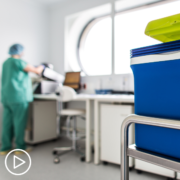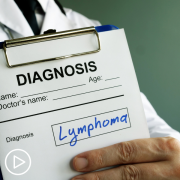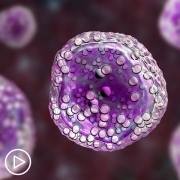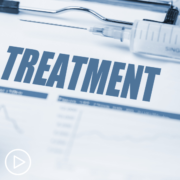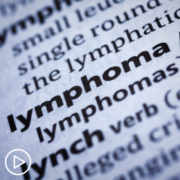What Are the Signs It Is Time to Treat Follicular Lymphoma?
What Are the Signs It Is Time to Treat Follicular Lymphoma? from Patient Empowerment Network on Vimeo.
What signs do follicular lymphoma patients show when it’s time to begin treatment? Cancer patient Lisa Hatfield and expert Dr. Jane Winter from Robert H. Lurie Comprehensive Cancer Center share some common symptoms of disease progression and advice for optimal care.
See More from START HERE Follicular Lymphoma
Related Resources:

|

|

|
Transcript:
Lisa Hatfield:
If you are living with follicular lymphoma and are currently in the watch and wait stage, you may wonder what symptoms you and your doctor are looking for that mean it’s time to start treatment. These signs and the timing may vary person-to-person, so it’s important to have a conversation with your doctor. Listen as Dr. Jane Winter from Robert H. Lurie Comprehensive Cancer Center at Northwestern University explains what symptoms she looks for to indicate treatment should start.
Dr. Jane Winter:
…The trigger for treatment is a big enough mass that it’s pushing on something important, for example, the ureter, which is the tube from the kidney to the bladder. And if we have a large mass that either wraps around that ureter or just pushes on it sufficiently to block drainage, it’ll result in a decline in kidney function. So, a rising creatinine may be the signal that things are progressing, and it’s time for treatment. Sometimes, the follicular lymphoma involving the lining around the lung can lead to what we call a pleural effusion, fluid in that space. It’s a potential space between the lung and the chest wall.
So, an accumulation of fluid there restricts the ability to take a deep breath, and that may be an indication for treatment, or just the overall total mass of disease is becoming such that it results in fatigue and is beginning to impair the quality of life and what we call performance status. So, those are triggers for treatment. Decline in blood counts is another. So, follicular lymphoma very commonly involves the bone marrow, and as it progresses and replaces the normal blood cells, it will result in a decline in the red cell count, the hemoglobin that carries oxygen.
So, it results in tiredness or shortness of breath, or a low white count such that the numbers of infection fighting cells is compromised…most often, it would be just a mild anemia that flags progression and bone marrow involvement. So, all of those. So, multi-disease, disease that causes symptoms, disease that causes fluid accumulation around the lung or obstruction of some important organ. These are all the signs that it’s time to think about treatment.
Lisa Hatfield:
As you’ve just heard, there are a variety of symptoms that can signal that it’s time to start treatment. This is why it’s crucial that you go to all appointments, especially ones where tests/labs are done, so your doctor has the most up to date information/data on your lymphoma. Also, be honest about what symptoms you are experiencing/how you are feeling. No symptom is too small and is important to disclose as that can show it’s time to start treatment.
Share Your Feedback:
Create your own user feedback survey






